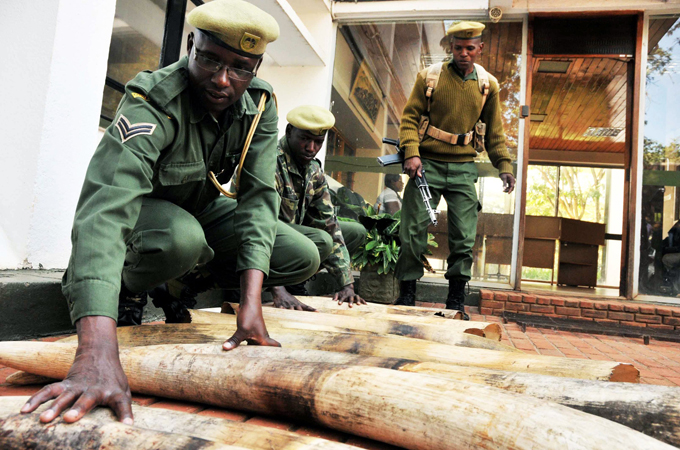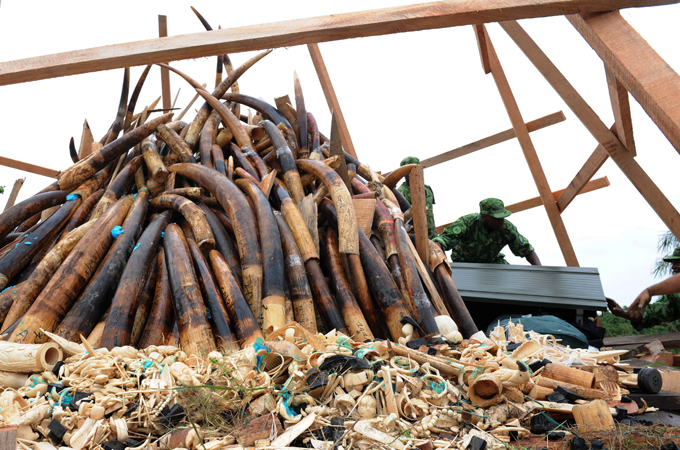Kenyan poachers make a killing in ivory
East African ivory and rhino horn continue to be in high demand, despite international efforts.
![Western tourists will pay to see live elephants, not rotting carcasses [Glen Johnson/Al Jazeera]](/wp-content/uploads/2013/06/201362915413599734_20.jpeg?resize=570%2C380&quality=80)
Meibae, Kenya – The shooter had laid up atop a flat, house-sized boulder – no more than 10 metres from the elephant – and blasted a bullet down through the animal’s head.
The poachers set to work, hacking off the tusks under a setting sun before scurrying up a rocky ridge, trekking off into the night. The slain elephant was around 25 years old, its tusks weighing five kilograms apiece.
Nearby, a herder grazing livestock heard the shot echo and began running for his manyatta settlement. Within three hours, 14 armed rangers converged at the nearest road access – an eight kilometre hike from where the elephant’s carcass lay.
The rangers were each of them Samburu tribesmen. Tracking is in their blood. But you can’t track without light. They waited until dawn. By the time they reached the carcass, the poachers had 10 hours on them.
“They were very clever,” said Chris Lentaam, a ranger, pointing at the rocky ridge beside the stinking carcass as he clutched his antiquated rifle. “They jumped between boulders so we couldn’t follow their footprints easily.”
Right now the demand for ivory is very high. When that happens, the price rises and suppliers go into over-drive.
The rangers tracked for a near solid two days, scouring the terrain for prints. But the poachers were long gone.
Near extinction
Throughout Africa, elephant and rhino poaching is reaching a level of frenzy. Tens of thousands of elephants are slaughtered each year, saws taken to their tusks as ivory prices soar, despite the trade being made illegal in 1989.
In the Democratic Republic of Congo (DRC), teams of poachers hunt from helicopters, packing serious firepower – rocket-propelled grenades and assault rifles. In the lawless, impoverished Central African Republic (CAR) around 90 percent of elephant deaths are attributable to poaching.
“Right now the demand for ivory is very high. When that happens, the price rises and suppliers go into over-drive,” says Paul Mbugua, spokesman for the state-run Kenya Wildlife Services. “While there is demand for ivory, nothing will stop these poachers.”
That demand is seen as coming from China – projecting influence across the continent and with a growing middle class – and other Asian end-markets, prompting World Wildlife Fund International Director Jim Leape to recently issue an appeal, as a team of 17 poachers were spotted headed towards a herd of 200 elephants in CAR.
“Ivory consumer country governments, and notably China and Thailand, must redouble their efforts to end demand – the root cause of the extermination of elephants across Africa,” he said.
However, experts note that demand for ivory is a global problem: from the United States, to Europe to South America, there are consumers willing to shell out.
Not since the bloodbaths of the 1980s has poaching been so severe. During that decade, the Kenyan elephant population dropped from 165,000 to 16,000.
If we find them hunting, we just kill them. We exchange fire; sometimes they escape, other times we kill them.
“The act of buying an ivory trinket is creating a situation that will see elephants and rhinos driven into extinction,” said Mbugua. Unless something is done, that extinction event, he says, will come within ten years.
Isiolo
Isiolo is a rough-and-ready African frontier town, hardened by years of neglect. It was an outpost for Somali soldiers during the First World War. Now it’s better known for the bandits that haunt the surrounding roads. A northeast Kenyan transport hub, it’s a place of apparitions – a face seen here one day is gone the next.
Long-haul truck driver. Smuggler. Somali fighter. Poacher. They all pass through Isiolo.
Fred Longonyek runs the ranger outpost in Meibae Conservancy, 100 kilometres from Isiolo. His 27 men patrol the area, tracking poachers, getting into firefights in the bush – and there are no half-measures.
“If we find them hunting, we just kill them,” he said. “We exchange fire; sometimes they escape, other times we kill them.”
He’s had a busy week, holding meetings at various manyatta dotted throughout the conservancy. The idea is to connect women making traditional Samburu necklaces and other handicrafts with broader markets, run under the auspices of the Northern Rangelands Trust (NRT). The trust encourages community-driven projects focused on conservation.
 |
| Isiolo, a northeast Kenyan town, is a central hub for the illicit ivory trade [AFP/Getty] |
Longonyek is convinced that if he can show that conservation puts dollars in pockets, then poaching can be stopped.
It’s simple, he says: where there are elephants, tourists will come. And tourists have money.
Isiolo is ear-marked as a future hub of Kenyan tourism.
Meibae Conservancy, unspoiled, is home to leopards, lions and cheetahs, the over-sized Kenyan wild dog, elephants, rhino, zebra and giraffes; inhabited by the Samburu, with the women’s necklaces stretching down their necks in great hoops and the men carrying spears, dressed in traditional garments. It’s an adventure tourist’s dream.
Once you have tourists, an entire economy emerges, the money filtering through the community, Longonyek says. With a community yielding the benefits of tourism dollars, poaching appeal lessens – tourists will pay big money to see an elephant stomping amid the lush African Savannah.
They won’t, however, pay to see a rotting elephant carcass engulfed by flies, its tusks hacked off.
“Once people know that conservation pays, they will start to think about preserving our wildlife,” said Longonyek.
Price of ivory
It’s difficult to say how much a kilogram of tusk is worth. That depends on whether you are a poacher, or a middle man, a merchant or an end-buyer. According to Mbugua, the right kind of rhino horn can fetch as much as $65,000 per kg.
Regardless, organising a shipment of several tonnes from an east African port can yield profits running well into the millions. And that’s the domain of the organised transnational crime kingpins, the shady Godfather figures who control the east African narcotics, human trafficking and ivory trade.
Harun Mwau was a member of parliament for years, heading Kenya’s transport ministry. He was also designated by the United States as a foreign narcotics kingpin in 2010.
Corruption is a global scourge and Kenya is no exception.
According to a 2011 International Peace Institute study, Termites at Work: Transnational Organised Crime and State Erosion in Kenya, “organised crime… has expanded and penetrated [Kenya’s] government and business structures to the extent that state institutions no longer have the capacity to counter it effectively”.
The east African black market kicks back to around a dozen figures – wealthy businessmen, politically protected – and their syndicates sprawl through a complex web of financiers, suppliers, middle men, dealers and smaller-scale merchants, and corrupt officials.
|
|
| Al Jazeera Correspondent: The last rhino |
“We have never made an arrest of a kingpin,” says Mbugua.
The United Nations Office on Drugs and Crime (UNODC) believes corrupt officials have provided false customs declarations, allowing shipments of ivory to leave the region.
The port at Mombasa, southeast Kenya, which ships 1,700 containers per day, is a pivotal point in the supply chain to global ivory markets and is emerging as a significant transit hub for the movement of heroin and cocaine, normally associated with the West African states and bound for the European underground.
Whomever controls Mombasa’s port, according to the IPI study, largely controls the movement of illicit materials from East Africa, estimated at $90bn per annum by the UNODC.
When shipments of ivory have been intercepted, it has proved impossible to trace genesis: The containers are registered to front companies.
Constant demand
In 2011, then Kenyan President Mwai Kibaki set the country’s stockpile of 335 ivory tusks ablaze, sending a message: ivory poaching would not be tolerated. However, several African states maintain ivory stockpiles, worth many millions of dollars, which their governments wish to sell-off, and hungry consumers want to buy.
“To these governments, their ivory has a value. So, the international community – or the first world – needs to raise the money and purchase all the stocks,” said Ian Craig, a long-time conservationist from the NRT executive board. “Then destroy it. Burn it all.”
The criminal justice systems throughout the region are not at the level they could be. They are dealing with transnational organizations, so there needs to be greater cross-border cooperation between relevant agencies
Since the international community banned ivory sales through CITES in 1989 – following the ten-year slaughter of elephants – there have been two large-scale sales, endorsed by CITES: to Japan in 1997 and to China and Japan in 2008. The idea was to flood the market with “legal” ivory, depressing prices and therefore undermining the black market.
Yet, there is “no evidence” to support advocate predictions that the sale of ivory from legal stockpiles “either satiated demand or reduced prices to the point where poached ivory has become financially untenable”, said the Environmental Protection Agency.
“In fact, the opposite has happened, with demand stimulated and poaching out of control.”
Indeed, in 2008, rather than flooding the market with cheap, “legal” ivory, China reportedly fixed the price high on the 68 tonnes of ivory it purchased at rock-bottom prices from southern African states, driving up perceptions of value, escalating demand.
Further, according to watchdogs, a situation was created whereby black market ivory was laundered onto the “legal” market. There have been year-on-year increases in poaching on the African continent ever since.
“No ‘legal’ ivory sales. Nothing,” says Craig. “It just adds fuel to the fire.”
Just two days before this reporter spoke to Craig, two black rhino – one just three days old – were gunned down on the Lewa conservancy, where Craig and the NRT is based. Despite the conservancy having aircraft patrolling the skies and a heavily armed protection unit, poachers got in, then out, with their haul of rhino horn.
Complex solutions
Halting the ivory trade requires a multi-faceted approach, experts note. State institutions and enforcement agencies must be strengthened, accompanied by cooperation between countries.
“The criminal justice systems throughout the region are not at the level they could be. They are dealing with transnational organisations, so there needs to be greater cross-border cooperation between relevant agencies,” said Gerhard von Rooyen, of the UNODC’s Nairobi office. “If not, it makes it extremely difficult to stop them.”
 |
| Governments have had little impact curbing the ivory trade [AFP] |
Meanwhile, the perception of ivory as valuable must be countered through public awareness campaigns in end-market countries, with pressure exerted on governments to crack down on the market with harsher sentencing, argued Angela Sheldrick, executive director of The David Sheldrick Wildlife Trust.
The Nairobi-based trust cares for orphan elephants; the youngest is a bumbling two-week-old.
“China treats its elephant populations like gods,” says Sheldrick. “If they don’t seriously attempt to counter demand, then action – in the form of sanctions – should be taken.”
Yet for Meibae’s rangers, the approach is simple. Standing aside the rotten elephant carcass, the acerbic stink of decay hangs heavy in the air, Lentaam looks at his beat-down old bolt action rifle – a relic from the British colonial era.
The magazine holds a meagre ten rounds.
“How can I fight poachers with this?” he says. “It’s dangerous for us, they have machine guns.”
“Give us automatic weapons.”
Follow Glen Johnson on Twitter: @GlenAJohnson